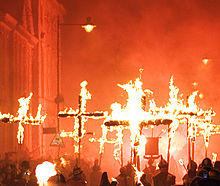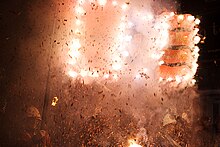
East Sussex is a ceremonial county in South East England. It is bordered by Kent to the north-east, West Sussex to the west, Surrey to the north-west, and the English Channel to the south. The largest settlement is the city of Brighton and Hove, and the county town is Lewes.

Lewes is the county town of East Sussex, England. The town is the administrative centre of the wider district of the same name and the location of East Sussex County Council at the county hall.
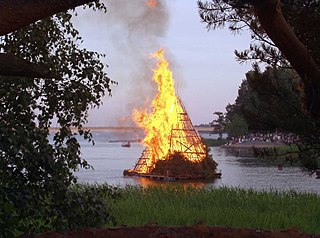
A bonfire is a large and controlled outdoor fire, used either for informal disposal of burnable waste material or as part of a celebration.
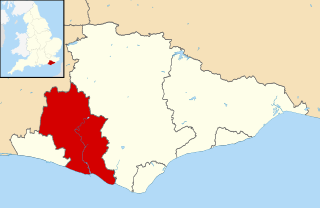
Lewes is a local government district in East Sussex, England. The district is named after the town of Lewes. The largest town is Seaford. The district also includes the towns of Newhaven, Peacehaven and Telscombe and numerous villages and surrounding rural areas. The Council is based at Marine Workshops a former industrial building in Newhaven which it shares with East Sussex Colleges Group.

An effigy is a sculptural representation, often life-size, of a specific person or a prototypical figure. The term is mostly used for the makeshift dummies used for symbolic punishment in political protests and for the figures burned in certain traditions around New Year, Carnival and Easter. In European cultures, effigies were used in the past for punishment in formal justice when the perpetrator could not be apprehended, and in popular justice practices of social shaming and exclusion. Additionally, "effigy" is used for certain traditional forms of sculpture, namely tomb effigies, funeral effigies and coin effigies.

Guy Fawkes Night, also known as Guy Fawkes Day, Bonfire Night and Fireworks Night, is an annual commemoration observed on 5 November, primarily in Great Britain, involving bonfires and fireworks displays. Its history begins with the events of 5 November 1605 O.S., when Guy Fawkes, a member of the Gunpowder Plot, was arrested while guarding explosives the plotters had placed beneath the House of Lords. The Catholic plotters had intended to assassinate Protestant king James I and his parliament. Celebrating that the king had survived, people lit bonfires around London. Months later, the Observance of 5th November Act mandated an annual public day of thanksgiving for the plot's failure.
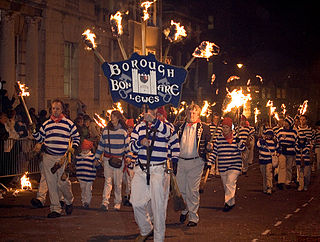
The Sussex Bonfire Societies are responsible for the series of bonfire festivals concentrated on central and eastern Sussex, with further festivals in parts of Surrey and Kent from September to November each year.
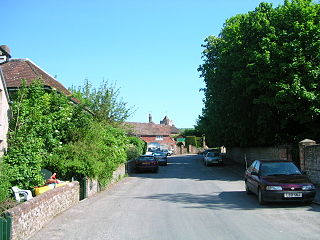
Firle is a village and civil parish in the Lewes district of East Sussex, England. Firle refers to an old-English/Anglo-Saxon word fierol meaning overgrown with oak. Although the original division of East Firle and West Firle still remains, East Firle is now simply confined to the houses of Heighton Street, which lie to the east of the Firle Park. West Firle is now generally referred to as Firle although West Firle remains its official name. It is located south of the A27 road four miles (9 km) east of Lewes.

The burning of Judas is an Easter-time ritual that originated in European Christian communities where an effigy of Judas Iscariot is burned. Other related mistreatment of Judas effigies include hanging, flogging, and exploding with fireworks. A similar ritual in Jewish tradition would be the hanging and burning an effigy of Haman and his ten sons during Purim, although this is not a widespread contemporary practice.
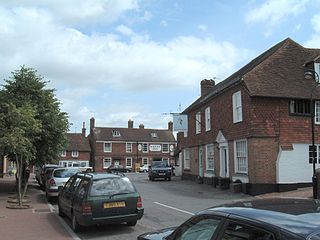
Rotherfield is a village and civil parish in the Wealden District of East Sussex, England. It is one of the largest parishes in East Sussex. There are three villages in the parish: Rotherfield, Mark Cross and Eridge. The River Rother, which drains much of the county and discharges at Rye Harbour, has its source on the south side of the hill on which Rotherfield village is built.

The West Country Carnival Circuits are an annual celebration featuring a parade of illuminated carts in the English West Country. The celebration dates back to the Gunpowder Plot of 1605. The purpose is to raise money for local charities.

Lewes Priory is a part-demolished medieval Cluniac priory in Lewes, East Sussex in the United Kingdom. The ruins have been designated a Grade I listed building.

East Sussex County Council is the upper tier local authority for the non-metropolitan county of East Sussex in England.

Lewes Free Presbyterian Church, based in the Jireh Chapel, is one of seven Free Presbyterian Church of Ulster places of worship in England. The Jireh Chapel is a former Calvinistic Independent chapel in the Cliffe area of Lewes, the county town of East Sussex and the main town in the local government district of Lewes. It is more than 200 years old and has been designated a Grade I Listed building.

Richard Woodman was a Protestant martyr, who was born in Buxted and lived in nearby Warbleton in East Sussex. He was burnt during the Marian Persecutions in 1557 in Lewes. The cult of the Sussex Martyrs is said to have been started using an etching by James Henry Hurdis of Woodman burning as a Protestant martyr.

Mark Antony Lower F.S.A. M.A. was a Sussex historian and schoolteacher who founded the Sussex Archaeological Society. An anti-Catholic propagandist, Lower is believed to have started the "cult of the Sussex Martyrs", although he was against the excesses of the "Bonfire Boys".

Pope Night was an anti-Catholic holiday celebrated annually on November 5 in the colonial United States. It evolved from the British Guy Fawkes Night, which commemorates the failure of the Gunpowder Plot of 1605. Pope Night was most popular in the seaport towns of New England, especially in Boston, where it was an occasion for drinking, rioting, and anti-elite protest by the working class.
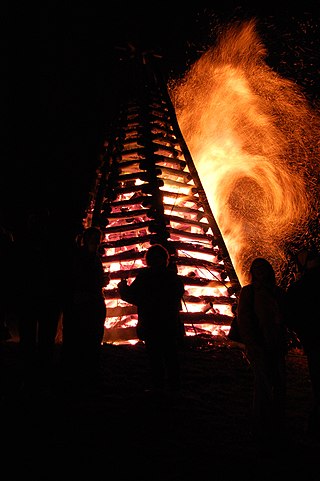
Bonfire Night is a name given to various annual events characterised by bonfires and fireworks. The event celebrates different traditions on different dates, depending on the country. Some of the most popular instances include Guy Fawkes Night in Great Britain, which is also celebrated in some Commonwealth countries; Northern Ireland's Eleventh Night, and 5 November in Newfoundland and Labrador. In various parts of Ireland, Bonfire Nights are held on Saint John's Eve, Bealtaine eve and Halloween. Due to the Thanksgiving Act, up until 1859 celebration of Guy Fawkes Night in the UK was legally mandated, which evolved into the Bonfire Night of today.
The history of Christianity in Sussex includes all aspects of the Christianity in the region that is now Sussex from its introduction to the present day. Christianity is the most commonly practised religion in Sussex.
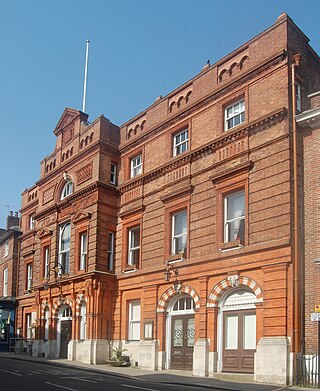
Lewes Town Hall is a municipal building in the High Street in Lewes, East Sussex, England. The structure, which is the meeting place of Lewes Town Council, is a Grade II listed building.
